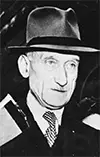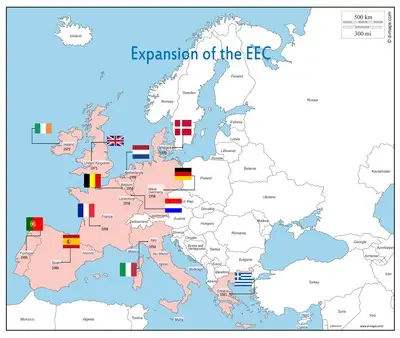The European Union
Part 1: Origins and Development The European Union is an international economic and political organization comprising most of the countries of Europe. It dates to 1992 but had its origins in the wake of World War II. 
The European Coal and Steel Community (ECSC) began as an attempt to forestall yet another military conflict between France and Germany. French Foreign Minister Robert Schuman (left) proposed a common market for coal and steel, an agreement that would unite those two countries (West Germany, since the post-World War II division) in an economic and political association aimed at cooperation and common benefit. It was no accident that coal and steel had powered the war machines of the antagonists; however, the economic elements of the common market were more forward-looking and wide-ranging because of the abolishment of customs duties, subsidies, and other kinds of restrictive practices. Yet another Treaty of Paris came along in 1951, and the result was the creation of the ECSC. It wasn't just France or West Germany onboard; also joining were Belgium, Italy, Luxembourg, and the Netherlands. (All but Italy were already engaged in negotiations that would eventually create the Benelux Union.) 
The parliaments of all six nations voted in favor of creating and joining the ECSC and so it came into being, signed on April 18, 1951 and beginning operation on July 23, 1952. At the time, many political leaders sought more ways to join efforts. Two other high-profile entities proposed were the European Defence Community and the European Political Community. The former ended up being rejected by France and Italy (having been ratified by the other four member states) and so never took effect. As well, the French Parliament rejected the political entity and so efforts continued in that vein under different auspices. An international conference in 1956 led to a series of agreements that produced the 1957 Treaty of Rome, which established a new entity titled the European Economic Community (EEC). Also coming into existence as a result of the Treaty of Rome was the European Atomic Energy Community (Euratom), which existed to promote market cooperation in the advent of nuclear power. 
The EEC began with the same six members: Belgium, France, Italy, Luxembourg, the Netherlands, and West Germany. In 1961 and 1962, four more nations applied to join: Denmark, Ireland, Norway, and the United Kingdom. Opposition from France halted progress on those applications for a number of years. In the meantime, Spain applied for membership but, because its government (under Francisco Franco) was a dictatorship, the EEC members refused, in 1964. As well, Greece, which had joined as an associate member in 1961, was tossed out because a coup in 1967 had replaced the country's representative government with a dictatorship. A change in government in France in 1969 resulted in the removal of opposition to expansion, and negotiations began anew. Norway did not join because its voters refused, in a 1972 referendum. On Jan. 1, 1973, however, Denmark, Ireland, and the U.K. did join the EEC. Two years later, Greece, a representative government once again, reapplied for membership; this application was successful, in 1981. Portugal and Spain, also turned democratic, applied in 1977 and joined in 1986. The member states of the EEC continued to discuss more opportunities for cooperation and common policies, most significantly in the 1986 Single European Act. After German reunification in 1990, the West German element of the EEC became (only) the German element. In the end, large-scale negotiations created the 1992 Treaty of Maastricht, which created the European Union (EU), which superseded the EEC. Next to join were Austria, Finland, and Sweden, in 1995. Membership expanded in the 21st Century, as 10 countries joined in 2004: Cyprus, Czech Republic, Estonia, Hungary, Latvia, Lithuania, Malta, Poland, Slovakia, and Slovenia. Another expansion three years later brought Bulgaria and Romania into the fold. As well, the EU had launched an official currency, the euro, in 1999. The first member states began using euro paper notes and coins in 2002, and more states followed in subsequent years. However, only 19 of the 27 EU member states use the euro as official currency. The exceptions are Bulgaria, Croatia, Czech Republic, Denmark, Hungary, Poland, Romania, and Sweden. To date, the United Kingdom is the only EU member to leave, doing so in 2020. Next page > Functions and Governance > Page 1, 2 |
|
Social Studies for Kids
copyright 2002–2024
David White




